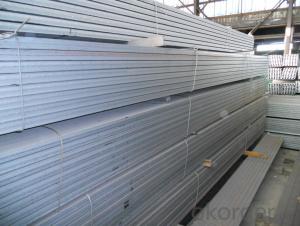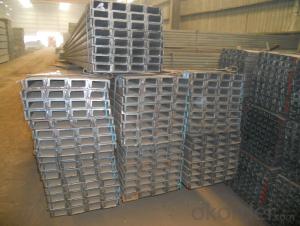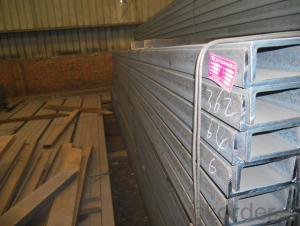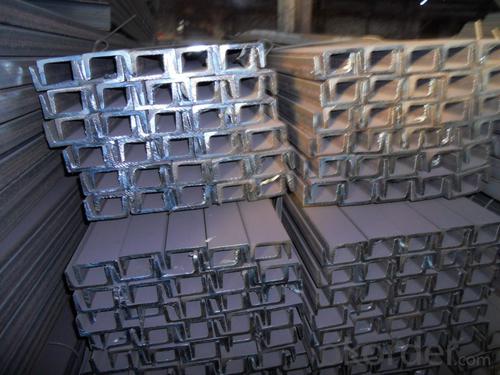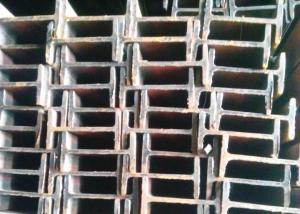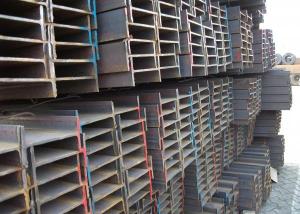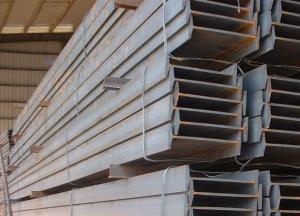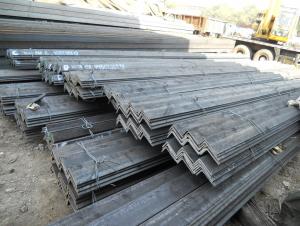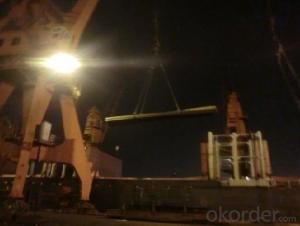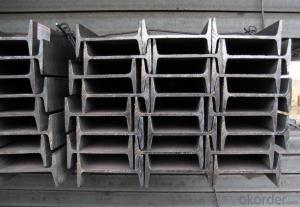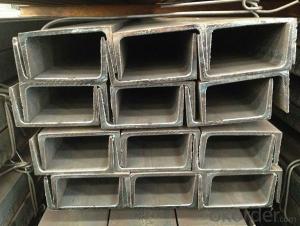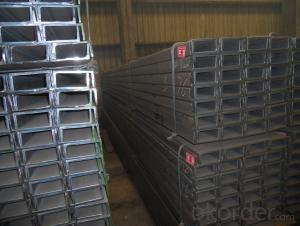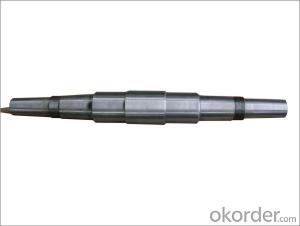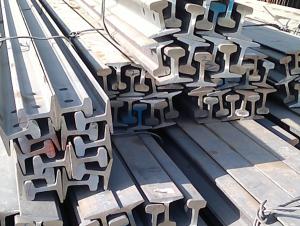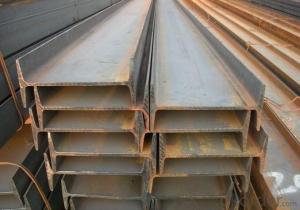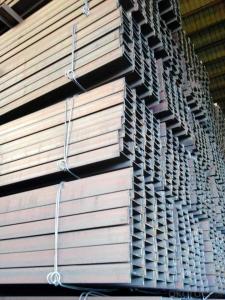High Quality Hot Rolled U-Channel Steel
- Loading Port:
- Tianjin
- Payment Terms:
- TT or LC
- Min Order Qty:
- 20 m.t.
- Supply Capability:
- 1000 m.t./month
OKorder Service Pledge
OKorder Financial Service
You Might Also Like
Product Description:
OKorder is offering Hot Rolled Steel U-Channel at great prices with worldwide shipping. Our supplier is a world-class manufacturer of steel, with our products utilized the world over. OKorder annually supplies products to European, North American and Asian markets. We provide quotations within 24 hours of receiving an inquiry and guarantee competitive prices.
Product Applications:
Hot Rolled Steel U-Channel can be applied to construction of warehouses, workshops, sport stadiums and car parks etc.The hot rolled channel steel belongs to carbon structural steel which is applied to in the field of construction and machinery.In details, the hot rolled channel steel is usually used for arch-itechtural structure, and they could be welded in order to support or hang a vari-ety of facilities. They are also usually used in combination with I beam. Generally,the hot rolled channel steel we supply must possess perfect welding property, riveting property and mechanical property and so on.
Product Advantages:
OKorder's Hot Rolled Steel U-Channel are durable, strong, and resist corrosion.
Main Product Features:
· Premium quality
· Prompt delivery & seaworthy packing (30 days after receiving deposit)
· Corrosion resistance
· Can be recycled and reused
· Mill test certification
· Professional Service
· Competitive pricing
Product Specifications:
We supply high quality MS Channel at reasonable price, including Chinese standard, Japanese standard and so on.
Standard | GB/JIS |
Material Grade | Q235,SS400 |
Technique: | Hot Rolled |
Sizes as per chinese standard: | 50*37*4.5mm - 300*89*11.5mm |
Sizes as per japanese standard: | 50*25*3mm – 200*80*7.5mm |
Length: | 6meter, 9meter, 12meter |
The chemical composition of HR Channel Steel according to Q235B
Alloy No | Grade | Element(%) | ||||
C | Mn | S | P | Si | ||
Q235 | B | 0.12-0.20 | 0.3-0.7 | ≦0.045 | ≦0.045 | ≦0.3 |
Alloy No | Grade | Yielding Strength Point(Mpa) | |||
Thickness(mm) | |||||
≦16 | >16-40 | >40-60 | >60-100 | ||
≧ | |||||
Q235 | B | 235 | 225 | 215 | 205 |
Package & Delivery of MS Channel:
1.The hot rolled channel steel will be packed in bundle with steel wire at each end of every bundle and color marking in order to help the customer to recognize his goods more easily at sight.
2. And the hot rolled channel steel could be loaded into 20ft or 40ft container, or by bulk cargo.If the weight of each bundle reaches more than 3.5 mt, the loading by break bulk cargo should be choosed.When the weight of each bundle reaches less than 3mt, the loading by container should be choosed.
3.As for the transportaion from mill to loading port, the truck will be usually used. And the maximum quantity for each truck is 40mt.
4.All in all, we could do in accordance with customer's request
FAQ:
Q1: Why buy Materials & Equipment from OKorder.com?
A1: All products offered byOKorder.com are carefully selected from China's most reliable manufacturing enterprises. Through its ISO certifications, OKorder.com adheres to the highest standards and a commitment to supply chain safety and customer satisfaction.
Q2: How do we guarantee the quality of our products?
A2: We have established an advanced quality management system which conducts strict quality tests at every step, from raw materials to the final product. At the same time, we provide extensive follow-up service assurances as required.
Q3: How soon can we receive the product after purchase?
A3: Within three days of placing an order, we will begin production. The specific shipping date is dependent upon international and government factors, but is typically 7 to 10 workdays.
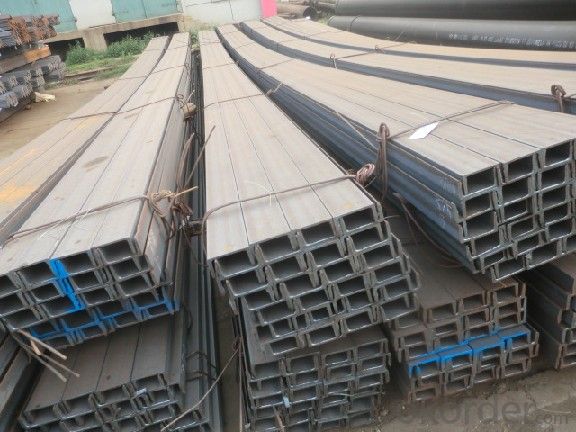
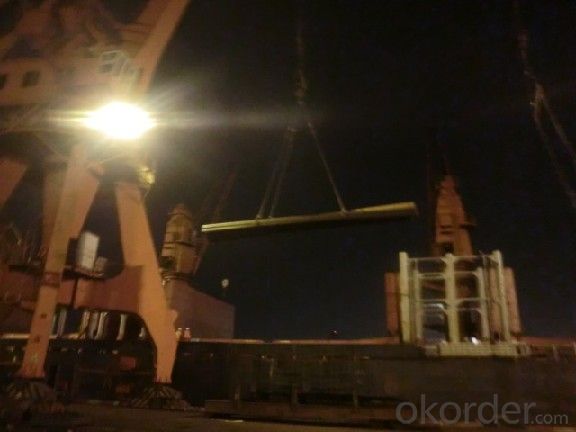
- Q: How long is the installation specification for the cantilever platform?
- The feeling should be as much as 1.25 times the cantilever length of the overhanging scaffolding, but actually the overhang is already very long and the anchor is not enough on the floor according to the theoretical value. We have not fixed the steel ring, so we have to pull it by wire rope, and there is skid resistant steel underneath.
- Q: What are the common methods of connecting steel I-beams to concrete structures?
- Various factors, including load requirements, structural design, and project specifications, determine the choice of method for connecting steel I-beams to concrete structures. Some commonly employed techniques include: 1. Embedding: Steel I-beams are embedded directly into the concrete structure by pouring concrete around their ends. This results in a robust and stable connection between the steel beams and the concrete structure. 2. Welding: Steel plates or brackets are welded onto the ends of the beams and then embedded or bolted into the concrete. Welding offers a durable and strong connection, often used in applications with high loads. 3. Bolting: Steel plates or brackets with pre-drilled holes are attached to the beam ends, and these plates are secured to the concrete using anchor bolts. Bolting allows for easy installation and disassembly, making it suitable for temporary structures or situations requiring frequent adjustments. 4. Epoxy adhesive: Epoxy adhesive is utilized to connect steel I-beams to concrete structures where drilling or welding is not preferred or feasible. Steel plates or brackets are bonded to the concrete using epoxy adhesive, creating a reliable and aesthetically pleasing connection. 5. Mechanical connectors: Mechanical connectors, such as steel clamps or brackets, are commonly employed to connect steel I-beams to concrete structures. These connectors offer a secure and adjustable connection, facilitating easy installation and beam alignment. Mechanical connectors are typically used in applications requiring flexibility and adjustability. It is essential to note that the specific method for connecting steel I-beams to concrete structures may vary based on project requirements, local building codes, and engineering recommendations. Consulting a structural engineer or professional in the field is crucial to ensure the appropriate technique is chosen for a specific project.
- Q: Can steel I-beams be used in warehouse construction?
- Yes, steel I-beams can be used in warehouse construction. They are commonly used as structural elements in warehouses due to their strength, durability, and ability to support heavy loads. Steel I-beams provide a reliable and cost-effective solution for constructing large, open spaces required in warehouse facilities.
- Q: How do steel I-beams perform in terms of sound transmission?
- Steel I-beams are generally poor at sound transmission due to their dense and rigid structure. The solid steel construction helps to minimize sound waves passing through them, making them effective in reducing sound transmission.
- Q: Where is the difference between I-beam and H?!
- Technically, H can be hot rolled or welded, and the I-beam is hot rolled
- Q: Can steel I-beams be used in energy-efficient building renovations?
- Yes, steel I-beams can be used in energy-efficient building renovations. Steel I-beams offer several advantages that make them suitable for energy-efficient renovations. Firstly, steel is a highly durable and strong material, allowing I-beams to provide structural support while reducing the need for excessive materials and construction. This can help minimize waste during renovation projects. Additionally, steel I-beams have a high load-bearing capacity, allowing for the creation of open floor plans and the integration of large windows, which enhances natural lighting and reduces the need for artificial lighting during the day. Furthermore, steel is a sustainable material that can be recycled, reducing the environmental impact of the renovation process. The use of steel I-beams also allows for the incorporation of insulation materials, such as spray foam or rigid foam, which can significantly improve the building's energy efficiency by reducing heat transfer. Moreover, steel I-beams can be designed to support the installation of energy-efficient systems, such as solar panels or green roofs, which contribute to the overall energy efficiency of the building. These systems can generate renewable energy and reduce the building's reliance on traditional energy sources. In conclusion, steel I-beams can be effectively used in energy-efficient building renovations. Their strength, durability, recyclability, and compatibility with energy-efficient systems make them a suitable choice for sustainable and environmentally friendly building projects.
- Q: What are the different types of corrosion protection methods for Steel I-Beams?
- Steel I-Beams have a range of corrosion protection methods available to prevent or reduce the impact of corrosion on their structural integrity over time. Here are some commonly used methods: 1. Galvanization: A popular method involves coating the steel beams with zinc, which acts as a sacrificial anode. As a result, the zinc corrodes instead of the steel, protecting it from rust. 2. Paint Coating: Applying a high-quality paint coating creates a barrier between the steel surface and moisture or oxygen, effectively preventing corrosion. 3. Epoxy Coating: In harsh environments, epoxy coatings offer excellent resistance to chemicals, moisture, and abrasion, thereby extending the lifespan of the steel beams. 4. Powder Coating: This method involves applying a dry powder to the steel beams and heating it to form a protective layer. The coating provides outstanding resistance to corrosion, impacts, and UV radiation. 5. Cathodic Protection: Sacrificial anodes or impressed current systems can be used to protect the steel beams. Sacrificial anodes made of zinc or aluminum corrode instead of the steel, while impressed current systems use an external power source to prevent corrosion. 6. Barrier Films: Thin protective coatings known as barrier films create a protective barrier between the steel surface and the corrosive environment. These films can be applied using different methods and offer effective corrosion protection. When selecting a corrosion protection method for Steel I-Beams, factors such as the environment, expected lifespan, and maintenance requirements should be considered. Each method has its advantages and limitations, and the choice should be based on the specific needs and conditions of the project. Regular inspections and maintenance are essential to ensure the long-term effectiveness of the chosen corrosion protection method.
- Q: What are the common challenges in erecting steel I-beams on-site?
- Some common challenges in erecting steel I-beams on-site include the need for heavy machinery and equipment to lift and position the beams, ensuring the proper alignment and levelness of the beams, coordinating with other trades and contractors to ensure a smooth installation process, and addressing any unexpected site conditions or obstacles that may hinder the installation process. Additionally, safety considerations and adherence to building codes and regulations are important factors to consider during the installation of steel I-beams.
- Q: What are the considerations for steel I-beam design in high-humidity areas?
- When designing steel I-beams for high-humidity areas, there are several considerations that need to be taken into account to ensure the structural integrity and longevity of the beams. Firstly, the choice of materials is crucial. Stainless steel or galvanized steel is often preferred for I-beams in high-humidity environments due to their corrosion resistance properties. These materials have a protective layer that prevents the formation of rust or corrosion, which can weaken the structural integrity of the beams. Secondly, the design should incorporate proper ventilation and drainage systems to prevent the accumulation of moisture. Moisture can accelerate the corrosion process, so it is essential to allow for proper airflow and drainage to keep the I-beams as dry as possible. This can be achieved through the use of weep holes, vents, or even the incorporation of a protective coating or insulation. Additionally, regular maintenance and inspection should be carried out to identify and address any signs of corrosion or damage. High-humidity areas can be particularly challenging because moisture levels are consistently high, increasing the risk of corrosion. Therefore, it is crucial to implement a maintenance plan that includes regular inspections, cleaning, and repairs if necessary. Moreover, it is important to consider the environmental factors in a high-humidity area. For example, if the area is also prone to saltwater exposure or chemical pollutants, additional precautions may be required. In such cases, a higher grade of stainless steel or specialized coatings may be necessary to provide enhanced corrosion resistance. Lastly, consulting with structural engineers or experts in steel design for high-humidity areas is highly recommended. These professionals can provide valuable insights and guidance in selecting the appropriate materials, designing efficient drainage systems, and implementing effective maintenance practices. By considering these factors, designing steel I-beams for high-humidity areas can ensure their durability and minimize the risk of corrosion, ultimately maintaining the structural integrity of the beams over time.
- Q: How are steel I-beams used in residential construction?
- Steel I-beams are commonly used in residential construction as load-bearing members to provide structural support. They are typically used for spanning long distances and supporting heavy loads, such as in the construction of large openings, like windows and doors, or in the creation of open floor plans.
Send your message to us
High Quality Hot Rolled U-Channel Steel
- Loading Port:
- Tianjin
- Payment Terms:
- TT or LC
- Min Order Qty:
- 20 m.t.
- Supply Capability:
- 1000 m.t./month
OKorder Service Pledge
OKorder Financial Service
Similar products
Hot products
Hot Searches
Related keywords

